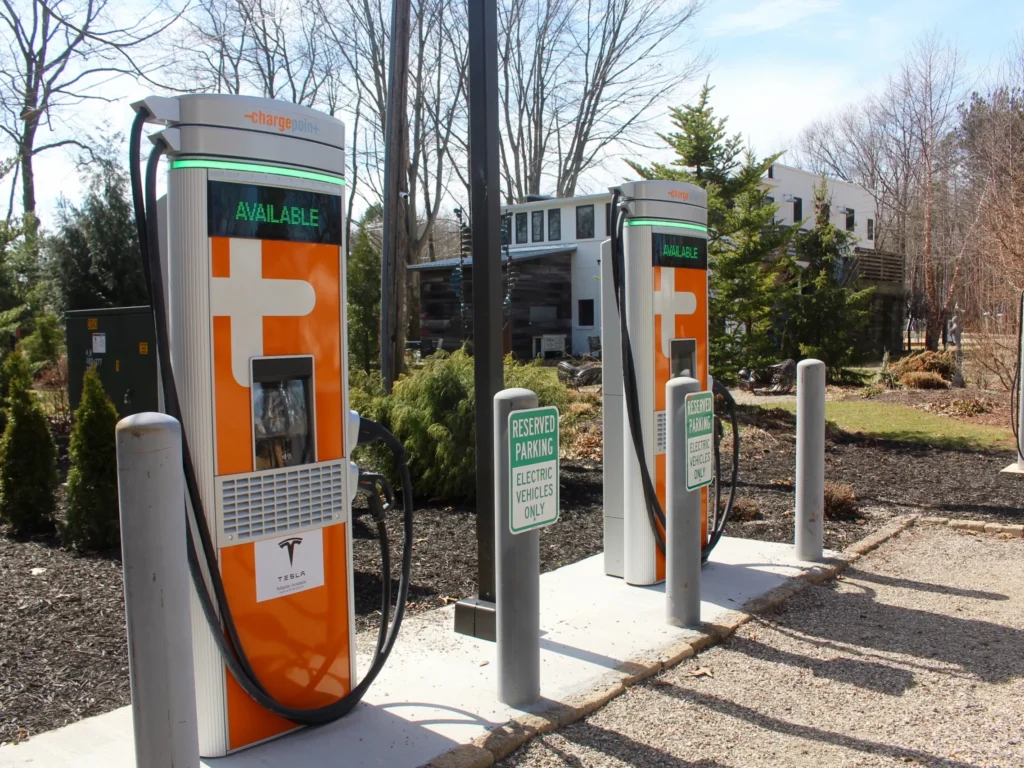EV Charging for Multi-Family Properties: A Smart Strategy to Attract Tenants, Generate New Revenue, Maximize State and Federal Incentives, and Boost Property Value. It’s a Win-Win!

Attract and retain desirable residents
Electric vehicle (EV) charging is a valuable amenity residents rely on, building loyalty and lasting relationships.
Differentiate your property
from competitors
According to a 2022 survey, 47% of millennials, 41% of Gen Zers and 38% of Gen Xers want to purchase an EV as their next vehicle.

Turn your parking spots into profit centers
EV drivers are willing to pay more for parking spaces that allow them to charge at home, increasing your revenue and ROI. EV charging also raises property values.

Get an
excellent ROI
Now is the best time to invest in EV charging. Generous incentives and subscription pricing make it affordable for any business.
EV charging is as required as having a gym.
It’s beyond an amenity, it’s beyond a nice-to-have.
How much can you earn by installing EV chargers at your multi-family property?
Use this simple calculator to estimate your potential revenue.
WHAT KIND OF EV CHARGING IS APPROPRIATE FOR MY MULTIFAMILY COMMUNITY?
Electric vehicle adoption is on the rise and here to stay. Multifamily developers have the opportunity to incorporate EV charging as an amenity for their residents, potentially leveraging it as a long-term revenue stream. Builders can take several approaches: 1) designate a percentage of tenant parking areas as “EV ready” to meet immediate codes; 2) install a few Level II or III EV chargers in communal parking areas; or 3) implement a comprehensive plan for smart EV charging and billing to be integrated throughout the community. EnFin can assist builders in identifying the best solution based on their community’s needs.
What the EV revolution means for your multifamily property
Preparing Your Property for the Future with EV Charging
Offering electric vehicle (EV) charging at your apartment or condominium property can significantly enhance its future readiness. As EVs become increasingly common, the tipping point for widespread adoption is approaching rapidly. BloombergNEF (BNEF) forecasts that by 2025, EVs will account for nearly 30% of new vehicle sales in the U.S. and Europe—a nearly tenfold increase from the start of this decade. By 2040, this figure is expected to rise to 85%.
Real estate consulting leader RCLCO notes, “Many real estate owners already are, or should be, responding to this dramatic growth in EV sales by offering charging stations at their properties.”
For multifamily property owners, managers, and HOAs, it’s crucial to move beyond a wait-and-see approach. EV charging is becoming a key amenity for residents deciding where to live. For those already driving EVs, it’s a necessity. Over 80% of people worldwide charge their vehicles where they live or work. Just as you wouldn’t go out of your way to charge your everyday devices, residents prefer the convenience of charging at home.
Four easy steps to get started
EV charging for any scenario
Charging at your property can be easy, convenient and well-managed, no matter your parking configuration.

Assigned charging
If you offer residents dedicated parking spaces with a shared meter, assigned charging is best for your property.
- Assign charging stations to residents.
- Set up property owner or driver to pay for charging.
- Allow property owner to handle installation and maintenance.
- Find out why your residents will need charging.

Community charging
If your residents park in a different spot every day, community charging is best for your property.
- Provide shared stations to residents.
- Enable drivers to easily check station availability or “get in line” to charge.
- Manage installation and maintenance on your own or ChargePoint can provide this support.
- Find out more about CPF50.

Mixed-use charging
If you offer resident and public charging, a mixed-use solution is best.
- Share charging between the public and residents.
- Set up charging for any use case or access level.
- Leverage Level 2 AC and DC fast charging.
- Find out more about CT4000.
Easy software management
ChargePoint makes it simple to offer your residents EV charging and let your team focus on what they do best.
- Connect with turnkey building management systems.
- Leverage proactive monitoring and full vehicle interoperability.
- Automatically manage and redistribute energy load across stations.
- Collect data to better understand resident charging experience.
- Find out more about our software.
WHAT PERCENTAGE OF PARKING AREAS ARE NECESSARY FOR TODAY AND INTO THE FUTURE?
Currently, in California and elsewhere, code requirements mandate a small percentage of multifamily parking areas to be designated as “EV ready” (typically 5%-10% depending on the code cycle). The exact definition of “EV-ready” may vary. Nevertheless, with projections indicating significant growth in electric vehicle sales, many multifamily developers are preparing for widespread EV adoption by installing electrical infrastructure for future expansion.
ARE THERE WAYS TO PREPARE THE INFRASTRUCTURE NOW FOR FUTURE RETROFIT?
Absolutely. Many multifamily developers are choosing to install the necessary infrastructure (such as conduits, pull boxes, breakers, electrical panels, etc.) for future EV expansion and retrofit. It’s crucial to incorporate this infrastructure well in advance, preferably during the early construction cycle before pouring foundations and hardscaping.
WHO PAYS FOR THE EV ENERGY BILLS AND HOW ARE THEY METERED?
Some multifamily developers are individually wiring EV charging to assigned parking spaces and associating meters and corresponding bills with the respective tenants. Others are opting for smart EV charging and load management software to recover charges directly from each driver. In this scenario, the multifamily owner allocates the collected funds toward a house account meter, often offset in part by solar generation credits. Properly set up, offering EV charging can attract renters to the community and potentially introduce a new revenue stream for the owner.
IS THERE A WAY TO CAPITALIZE ON THIS TREND?
Indeed. By incorporating smart EV charging and load management software, it’s possible to recover charges directly from each driver. Moreover, in some locations, these meters can be partially offset by applying solar generation credits. Consequently, depending on the rate charged to drivers and the total amount of solar credits applied to the account, the owner can achieve a profitable net operating income while still offering an attractive amenity for tenant EV drivers.
CAN SOLAR GENERATION GO HAND-IN-HAND WITH SMART EV CHARGING & BILLING?
Yes, by integrating smart EV charging and load management software, the amortized cost of solar typically remains below the price that can be charged/billed to EV drivers. Depending on the rate charged to drivers and the total amount of solar credits applied to the account, the owner can potentially achieve profitable net operating income while still offering an attractive amenity for tenants who are EV drivers. Explore EV Charging for Multi-Family Properties with ChargePoint.








